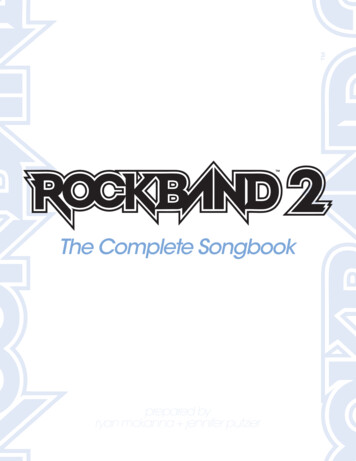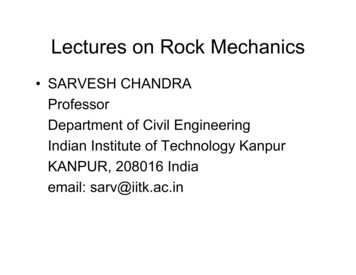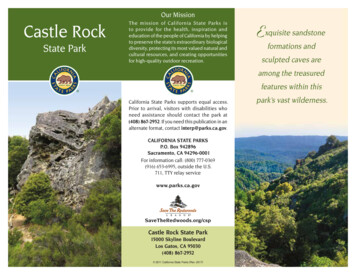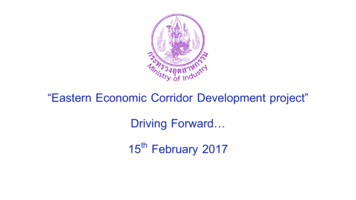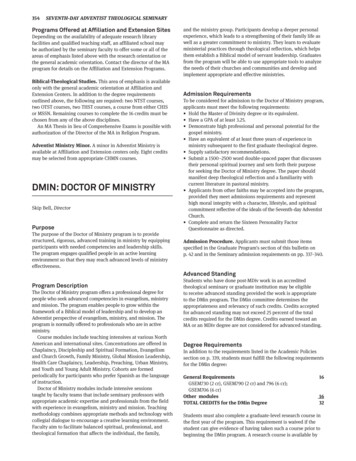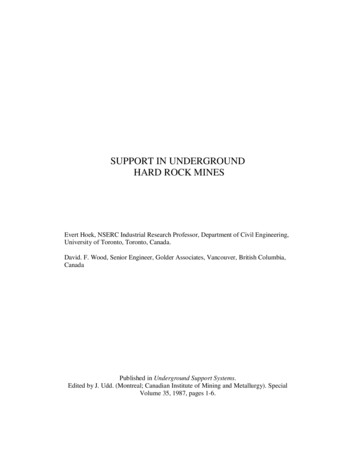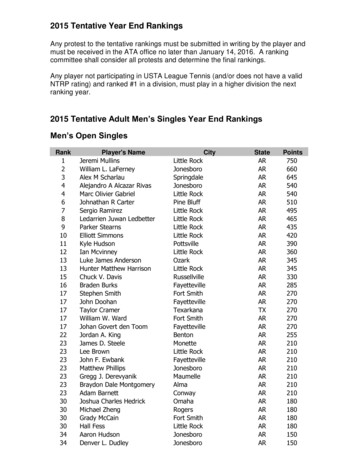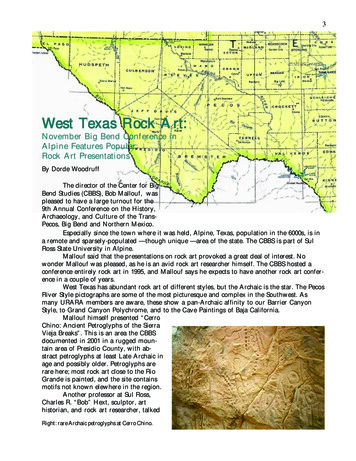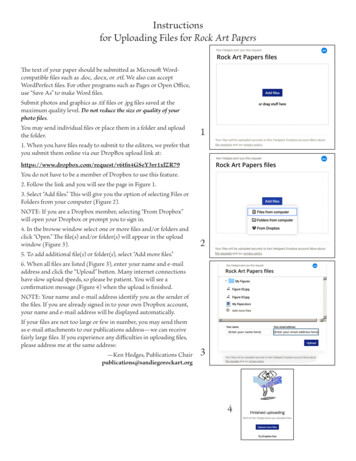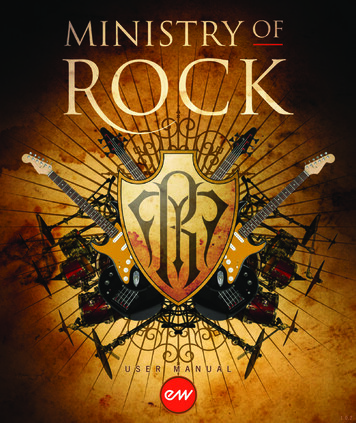
Transcription
U S E RM A N U A L1.0.2
EASTWEST MINISTRY OF ROCKIMPORTANT COMPATIBILITY NOTE!Our Revolutionary New Opus Software EngineOur brand new Opus software engine has been years in development, and replacesthe Play engine. All EastWest Libraries (with the exception of the original HollywoodOrchestra, the original Hollywood Solo Instruments, and the MIDI Guitar Series) aresupported in Opus, allowing them to take advantage of a faster, more powerful, moreflexible, and better looking software engine.Opus comes with some incredible new features such as individual instrument downloads, customized key-switches, new effects for the mixer page, scalable retina userinterface upgrades for legacy products, a powerful new script language, and many morefeatures that allow you to completely customize the sound of each instrument.It’s one of the most exciting developments in the history of our company and will be thelaunching pad for many exciting new products in the future.Using Opus and Play TogetherOpus and Play are two separate software products, anything you have saved in yourprojects will still load up inside the saved Play version of the plugins. You can updateyour current/existing projects to Opus if you so choose, or leave them saved within Play.After purchasing or upgrading to Opus you do not need to use Play, but it may be moreconvenient to make small adjustments to an older composition in your DAW loading theinstruments saved in Play instead of replacing them with Opus. For any new composition, just use Opus.A Note About User ManualsAll EastWest Libraries have their own user manuals (like this one) that refer to instruments and controls that are specific to their respective libraries, as well as referencingthe Play User Manual for controls that are common to all EastWest Libraries.For EastWest Libraries supported for use within Opus, we highly recommend takingadvantage of all the powerful new features it has to offer.Reference this user manual for details related to the instruments and controls specificto this library and, in place of the previously mentioned Play Software Manual, refer tothe Opus Software Manual from the link below instead.OPUS SOFTWARE MANUAL: tware-Manual.pdfii
EASTWEST MINISTRY OF ROCKThe information in this document is subject to change without notice and does not represent a commitment on the part of East West Sounds, Inc. The software and soundsdescribed in this document are subject to License Agreements and may not be copiedto other media. No part of this publication may be copied, reproduced or otherwisetransmitted or recorded, for any purpose, without prior written permission by East WestSounds, Inc. All product and company names are or trademarks of their respectiveowners. East West Sounds, Inc., 2007. All rights reserved.East West Sounds, Inc.6000 Sunset Blvd.Hollywood, CA 90028USA1-323-957-6969 voice1-323-957-6966 faxFor questions about licensing of products: licensing@eastwestsounds.comFor more general information about products: .comiii
EASTWEST MINISTRY OF ROCK1. Welcome23456About EastWestProducer: Nick PhoenixCreditsHow to Use This and the Other ManualsOnline Documentation and Other Resources1
EASTWEST MINISTRY OF ROCKWelcomeAbout EastWestEastWest (www.soundsonline.com) has been dedicated to perpetual innovation and uncompromising quality, setting the industry standard as the most critically acclaimedproducer of Sample CDs and Virtual (software) Instruments.Founder and producer Doug Rogers has over 30 years experience in the audio industryand is the recipient of many recording industry awards including “Recording Engineer ofthe Year.” In 2005, “The Art of Digital Music” named him one of “56 Visionary Artists &Insiders” in the book of the same name. In 1988, he founded EastWest, the most critically acclaimed sound developer in the world, and recipient of over 50 industry awards,more than any other sound developer. His uncompromising approach to quality, and innovative ideas have enabled EastWest to lead the sound-ware business for 20 years.In 1997 Rogers partnered with producer/composer Nick Phoenix and set up QuantumLeap, a wholly owned division of EastWest, to produce high-quality, no-compromise sample libraries and virtual instruments. Quantum Leap virtual instruments are mostly produced by Nick Phoenix. Some of the larger productions, such as Symphonic Orchestra,Symphonic Choirs and Quantum Leap Pianos are co-produced by Doug Rogers and NickPhoenix. As a composer, Phoenix began scoring film trailers and television commercialsin 1994. To date, he has either scored or licensed music for the ad campaigns of over1000 major motion pictures including Tomb Raider 2, Terminator 3, Lord of the RingsReturn of the King, Harry Potter 2, Star Wars Episode 2, Spiderman 3, Pirates of theCaribbean 3, Blood Diamond, Night at the Museum, and The Da Vinci Code. QuantumLeap has now firmly established itself as one of the world’s top producers of high-endsample libraries and virtual instruments.In 2006, EastWest purchased the legendary Cello Studios (formerly United Western Recorders) on Sunset Boulevard in Hollywood, re-naming it EastWest Studios. The 21,000sq. ft. facility, since remodelled by master designer Philippe Starck, houses five recording studios and is the world headquarters for EastWest.Chapter 1: Welcome2
EASTWEST MINISTRY OF ROCKProducer: Nick PhoenixBorn in London, England, in 1967, Nick began scoring film trailers and television commercials in 1994. To date, he has either scored or licensed music for the ad campaignsof over 1000 major motion pictures. “Spiderman 3.” “Pirates of the Caribbean 3,” “Fantastic Four, Silver Surfer,” “300,” “Sunshine,” “The Last Mimzy,” “Hannibal Rising,”“Blood Diamond,” “Night at the Museum,” “Superman Returns,” “Astronaut Farmer,”“Rush Hour 3,” “Eragon,” and “The Da Vinci Code” are a few recent examples. Nick hasalso scored numerous TV shows for NBC, CBS, Showtime, Fox Family, and the HistoryChannel.The journey as a composer has also inspired Nick to record and program his own soundsand samples. Nick founded Quantum Leap Productions in 1997 and Quantum Leap hassince grown to be the most critically acclaimed producer of high-end sample librariesand virtual instruments. Nick’s studio is located in Venice, California, and is 100% solarpowered.Quantum Leap titles to date: QL Guitar and Bass QL Brass QL 56 Strat QL Voices of the Apocalypse QL Rare Instruments QL Hardcore Bass QL Stormdrum EWQL Symphonic Orchestra EWQL Symphonic Orchestra XP EWQL Symphonic ChoirsQL RaQL ColossusQL GypsyQL Ministry of RockQL Voices of PassionQL Stormdrum 2EWQL PianosChapter 1: Welcome3
EASTWEST MINISTRY OF ROCKCreditsProducerNick PhoenixExecutive ProducerDoug RogersEngineeringNick Phoenix, Rhys Moody, Ashif HakikProgrammingNick Phoenix, Pierre Martin, Ashif HakikEditingPierre Martin, Nick Phoenix, Ashif HakikArt DirectionSteven Gilmore, Doug Rogers, Nick PhoenixSoftwareSam Fischmann, Klaus Voltmer, Patrick Stinson, Stefan Kersten,Klaus Lebkücher, Toine Diepstraten, Stefan Podell, Albert Ortega,Doug Rogers, Nick Phoenix, Rhys Moody, Stefan LeisteManualJohn PhilpitSpecial Thanks toShaun Ellwood, Gary MeyerbergChapter 1: Welcome4
EASTWEST MINISTRY OF ROCKHow to Use This and the Other ManualsAll documentation for the EastWest PLAY Advanced Sample System and its libraries isprovided as a collection of Adobe Acrobat files, also called PDFs. They can be viewed onthe computer screen or printed to paper.Each time you install one of the PLAY System libraries, two manuals are copied to thefile system on your computer: The manual that describes the whole PLAY System. This, the largest of the manuals,addresses how to install and use all aspects of the software that are common to alllibraries. The library-specific manual, such as the one you are currently reading. This smallerdocument describes aspects that differ from one library to the next, such as the listof included instruments and articulations.Using the Adobe Acrobat FeaturesBy opening the Bookmarks pane along the left edge of the Adobe Acrobat Reader, theuser can jump directly to a topic from the section names. Note that some older versionsof Acrobat Reader might not support all these features. The latest Acrobat Reader canbe downloaded and installed at no cost from the Adobe web site. (As an example of ahyperlink, you can click on the last word of the previous sentence to be taken directly tothe Adobe site.)When reading this and other manuals on the computer screen, you can zoom in to seemore detail in the images or zoom out to see more of the page at once. If an includedpicture of the user interface, or a diagram, seems fuzzy or illegible, then zoom in usingone of several means provided in the Acrobat Reader software.Online Documentation and Other ResourcesFor the most up to date information, visit the support pages at EastWest’s web site.There you can find: information made available after these manuals were written FAQ pages that may already list answers to questions you have suggestions from EastWest and other users of the EastWest PLAY System news about upcoming releasesThe address is:http://support.soundsonline.comChapter 1: Welcome5
EASTWEST MINISTRY OF ROCK2. Quantum Leap Ministry of Rock, An Overview8889The Design Point for the Ministry of Rock LibraryWhat’s IncludedNotes from the ProducerHardware Requirements6
EASTWEST MINISTRY OF ROCKQuantum Leap Ministry of Rock, An OverviewThe Design Point For the Ministry of Rock LibraryThe Quantum Leap Ministry of Rock Virtual Instrument is a library of rock drums, bassesand guitars recorded in the famous EastWest Studio 2. It is now the ultimate productiontoolbox for rock producers.The library covers a myriad of styles. Songwriters; film, TV, and game composers; anddrummers and guitarists will all love this library. The sound quality and playability aresuperior to anything else available.Ministry of Rock features sounds used in today’s music. The entire library was createdwith one goal in mind: to create a virtual instrument capable of producing sounds thatcould actually produce a hit record or filmscore without any live drum, bass, or guitaroverdubs. The articulations and programming were all reverse engineered from actualperformances.What’s IncludedThis Quantum Leap Ministry of Rock library you purchased includes all the following: a complete set of sample-based instruments, enumerated later in this manual approximately 20 Gigabytes of 24-bit, 44.1 kHz samples the EastWest PLAY Advanced Sample Engine the unique authorization code that identifies the license you bought manuals in Adobe Acrobat format for both the EastWest PLAY System and the Quantum Leap Ministry of Rock Virtual Instrument an installation program to set up the library, software, and documentation on yourcomputer an Authorization Wizard for registering your license in an online databaseOne required item not usually included is an iLok security key. If you already have onefrom an earlier purchase of software, you can use it. Otherwise, you need to acquire one.They are available from many retailers that sell EastWest and Quantum Leap products, oryou can buy one online from www.soundsonline.com.Notes from the ProducerSome Ministry of Rock patches load up with the Convolution Reverb, Delay, and Chorusenabled. This was done because these are typical setting for such instruments. You areencouraged to experiment with the fantastic Reverb and Chorus in the PLAY Engine tocreate your own effects.Chapter 2: Quantum Leap Ministry of Rock, An Overview7
EASTWEST MINISTRY OF ROCKNote: The high-quality Convolution Reverb in the EastWest PLAY Engine, mentionedabove, uses lots of CPU power. If your computer has the minimum system specs, turningoff the reverb after loading a patch may significantly improve performance.Some Ministry of Rock instruments take advantage of the PLAY Engine’s feature calledChannel Sourcing. It lets you access the two sides of the stereo file independently. Usethis control along with the Stereo Double knob to affect how wide a sound to generate.Some of the other PLAY System features working under the hood are used to achieve theMinistry of Rock sound. These include: auto legato detection legato scripts round robin articulations and two means for resetting the cycles repetition detectionHardware RequirementsSee the Play System manual for a complete list of the Hardware and Software Requirements for installing and running any PLAY System library. In addition, the availablespace on the hard drive required for a full installation of Ministry of Rock is approximately 20 GB (Gigabytes).Chapter 2: Quantum Leap Ministry of Rock, An Overview8
EASTWEST MINISTRY OF ROCK3. The Ministry of Rock User Interface121212131314Round Robin Reset ButtonStereo Double ControlsFilter ControlsADT ControlsThe Graphical Representation of the EnvelopeThe Browser View9
EASTWEST MINISTRY OF ROCKThe Ministry of Rock User InterfaceEach library presents its own interface when one of its instruments is the current one, asspecified in the Instruments drop-down in the upper right corner. The image at the bottom of the page provides an overview of the entire window when in Player View.Much of this interface is shared by all PLAY System libraries, and the common featuresare described in the PLAY System manual. The controls described here are: Round Robin Reset Stereo Double Filter ADT the graphical representation of the EnvelopeChapter 3: The Ministry of Rock User Interface10
EASTWEST MINISTRY OF ROCKRound Robin Reset ButtonA round robin articulation is one in which several different samples are recorded with allparameters, such as volume, speed of attack, and so on, being essentially constant. ThePLAY Engine then knows to alternate between the two or more samples during playback.The goal is to avoid what’s often called the “machine gun effect,” in which playing thesame sampled note repeatedly causes the unnatural sound of consecutive notes beingmechanically identical.There’s one potential problem with round robin technology, and one way to solveit is the Round Robin Reset button. The PLAY Engine remembers which sampleshould be played the next time the note sounds. If, for example, a round-robin patchcontains two samples, A and B, and a piece uses that note 7 times, the PLAY Engineplays A B A B A B A. If the piece is played again from the beginning, the engine will playstarting with B, because that’s next in order. The second rendition will be subtly different. Being able to reset all round-robin articulations to the beginning of the cycle allowsfor consistent playback.You can use this button to reset all round robin articulations on demand. Or use yourchoice of a MIDI note or MIDI control code to reset them one instrument at a time froma MIDI keyboard or the data stored in a sequencer project. See the description of theSettings dialog for more information about this articulation-specific approach.Stereo Double ControlsThis knob, with its three buttons, gives the user the option of using exclusively the left stereo signal or right when “Stereo” is selected from theChannel Source drop-down. For any other setting, this control has no effect. The reason for having the choice is that in some instruments the leftand right signals are separately recorded samples. For example, the LesPaul Standard guitar was recorded through a Buddha amp (clean setting)on the left and a Marshal stack on the right. You have the choice of using only the Buddha, only the Marshal or a mix of the two sounds.The knob lets the user determine the spread of the signals, how far apart the ear perceives the stereo channels to be. A value of 0% brings the two channels together at thecenter (unless the Pan knob positions the output differently), and is the equivalent ofturning off the controls with the button below the knob. A value of 100% call for themaximum spread available. Select between the left and right signal with the buttons oneither side of the knob.Filter ControlsThe Filter controls take the sound of the instrument, and modify it byfiltering out some of the sound above a certain frequency. This type ofeffect is commonly called a Low Pass Filter.Chapter 3: The Ministry of Rock User Interface11
EASTWEST MINISTRY OF ROCKThe Frequency knob determines where the sound starts to be filtered out. The Resonanceknob specifies how much the filter “rings” at the dialed frequency. The higher the resonance knob is set, the more focused this ringing becomes.The graph gives you visual cues about the frequency distribution you are creating withthe settings you select.ADT ControlsArtificial Double Tracking is a technique, invented at Abbey Road when the Beatles were recording there, that approximates the effect of double tracking (recording twonearly identical takes of a vocalist or instrument on thesame part and laying one on top of the other) without actually taking the time to record two takes. And some would say ADT improves on actualdouble tracking even beyond the savings in time. The original ADT process was based onmagnetic tape; in the PLAY Engine, the effect is created digitally. The software programmers, however, added a tape simulator to mimic the slight speed variations of the twoanalog tape machines that created the ADT effect.The Delay knob specifies in milliseconds, the delay between the original signal and thesecondary signal. A delay of around 40 ms is typical, so is often a good starting pointwhen crafting a specific effect.The Depth knob specifies the amount by which that delay is modulated. You don’t wanta exactly consistent delay; the delay of the secondary signal will vary forward and backward in time by this much.The Speed knob varies the speed at which that delay is modulated.The Level knob specifies the relative loudness of the secondary signal. Set it to 0.0 dB tohear the effect at its strongest, with the same level on both signals; higher or lower givespreference to one of the signals. The overall effect depends on their combination.The On/Off button allows you to kill the ADT effect instantly and then reinstate it with thesame settings, as needed.The Graphical Representation of the EnvelopeThe Envelope Controls are described in the main PLAY Systemmanual because they are common to all PLAY System libraries. Only some libraries include the graph, as shown here, soit is included in the manuals for those libraries only.Note that the total width of the graph represents the totallength of all phases of the envelope. Therefore, when youChapter 3: The Ministry of Rock User Interface12
EASTWEST MINISTRY OF ROCKchange something in one part of the graph, for example, the decay, you may see theslopes of other components, the attack and the release, change as well because thosephases become a larger or smaller percent of the whole; this is as expected.The Browser ViewThe Browser behaves identically among all PLAY System libraries. Read the main PLAYSystem manual for information about how to use that view.Chapter 3: The Ministry of Rock User Interface13
EASTWEST MINISTRY OF ROCK4. Instruments, Articulations, Keyswitches16181826Descriptions of the Ministry of Rock InstrumentsExplaining the Instrument Sub-typesTables of the InstrumentsAbbreviations Used in Articulation Names14
EASTWEST MINISTRY OF ROCKInstruments, Articulations, KeyswitchesThis chapter provides specific information about each of the instruments in the Ministryof Rock library. First is a section that briefly describes them in case some are unfamiliarto you. This is followed by a table that lists for each instrument the available articulations together with the keyswitch note that initiates each one. You might want to printout the pages containing this table as a reference.Descriptions of the Ministry of Rock InstrumentsThis is a list of all the basses and guitars in the Ministry of Rock library. Each item includes a brief description of the physical instrument and some general information aboutthe articulations. See the table later in this manual for specifics about what articulationsare available.The drum kits are described in a preface to the list of drums and other percussion, starting on page 24.Some instruments below specify different equipment being recorded for the left andright channels. When that’s the case, use the Channel Source and Stereo Doubling controls to use the left or right channel alone or a mix of the two.Fender 5 String BassA classic unmodified 5 string Fender Jazz recorded in stereo. An Ampeg SVT rig wasused in the right channel and an Ashdown rig in the left channel. Articulations includepick round robin, finger, slide up and down, staccato, bends, and FX.Fender P-BassThis P-Bass has been hot-rodded and recorded in stereo. An Ampeg SVT rig was usedin the right channel and an Ashdown rig in the left channel. Articulations include pickround robin, pick mute, slide up and down, staccato, bends, and FX.Kubicki BassThis is the famous rock/metal bass from the 80’s. It was recorded in stereo. An AmpegSVT rig was used in the right channel and an Ashdown rig in the left channel. Articulations include pick round robin, slide up and down, staccato, bends, and FX.Musicman HCB Demo BassBasic pick articulation of the Musicman bass from Hardcore Bass XP. The Hardcore Basslibrary has a different sound from Ministry of Rock.Chapter 4: Instruments, Articulations, Keyswitches15
EASTWEST MINISTRY OF ROCKSpecter BassSpecter basses are fantastically well made rock basses with bite. This one was also recorded in stereo. An Ampeg SVT rig was used in the right channel and an Ashdown rigin the left channel. Articulations include pick round robin, finger, slide up and down,staccato, bends, and FX.7 String Ibanez KRA DIRThis 7-string Ibanez guitar is the ultimate death metal guitar. The left channel is thesound of a Krank amp and the right side is clean. The patches default to mono fromleft in the Channel Sourcing control. This means you only hear the Krank amp in mono.Switch to mono from right for a clean tone and add your own amp plug-ins. Lead articulations and power chords are separated into 2 master patches. Auto legato detection workswonders here.Gibson J-160 AcousticThis is a famous guitar used by many famous rock bands from the 70’s. This patch is agiant acoustic guitar strumming toolkit. 6 chords are available in every key with multiplespeeds, up and down strums, short and long, and multiple dynamics. Use the Mod Wheelto change the speed.Les Paul Deluxe MAR BOGThis Les Paul Deluxe vintage guitar was recorded through a Bogner stack on the left anda Marshal stack on the right. It sounds great in stereo, or use the Channel Source controlto achieve the sound you want. Lead articulations and power chords are separated into 2master patches. Auto legato detection works wonders here. The many articulations makethis rock/metal guitar sing.Les Paul Standard MAR BUDThis Les Paul Standard vintage guitar was recorded through a Buddha amp (clean setting) on the left and a Marshal stack on the right. The instrument defaults to the Marshalsound in the Channel Source control. Switch to the Buddha and add your own plug-ins.Lead articulations and power chords are separated into 2 Master patches. Auto legatodetection works wonders here. A different take on the articulations make this guitar quitedifferent from the Les Paul Deluxe, above.Strat PRS Mono FenderThese are various Strat and Paul Reed Smith rhythm and FX patches in mono, playedthrough a Fender amp. Styles include punk, ska, rock, and garage.Telecaster VOX BOGThe Fender Telecaster was recorded through a Bogner clean channel on the left and aVox clean setting on the right. Chords and leads are separated into 2 Master patches.The Lead patch loads up with a cool reverb/chorus preset. Play an arpeggiated chord andexperiment with the pitch wheel.Chapter 4: Instruments, Articulations, Keyswitches16
EASTWEST MINISTRY OF ROCKExplaining the Instrument Sub-typesFor some instruments in Ministry of Rock, theremay be two or more .ewi files listed in the BrowserView. Examples are Tele Chords Master.ewi andTele Lead Master.ewi both listed under TelecasterVOX BOG. Here is an explanation of what thevarious sub-types in the instrument name mean.Master includes a keyswitch containing all articulations of the instrument except legatointervals. Once a Master patch is loaded, all articulations as well as the keyswitch notesthat trigger them can be found in the Articulations control near the bottom-right handcorner of the Player View. Articulations can be freely loaded or unloaded as needed.Elements is the same as Master except that only the default articulation, usually the oneat the top of the list, is loaded and active when first opened. You can load and activatedifferent articulations as needed. There is no keyswitch, which means it’s not easy toswitch to a different articulation in the middle of a performance. Instead, use an Elements patch when you need only a single articulation—or a consistent layering of multiple articulations—during the entire performance.Lead Master includes a keyswitch containing all the solo articulations of the instrumentexcept for the legato intervals.Chords Master includes a keyswitch containing all the chordal variations of the instrument.Tables of the InstrumentsThe following table lists all the articulations available in each instrument (.ewi file). Asis mentioned in the previous section on Instrument Sub-types, there may be more thanone instrument file for some physical instruments.The Ministry of Rock basses, guitars, and drums are in separate tables.Note that when an articulation is listed over a range, such as “C0-F#0,” that means thesamples are layered into every sample. The relative loudness of this layer to the mainsamples can be controlled with the volume sliders in the Articulations control. For example key clicks and other mechanical sounds naturally heard when the instrument isplayed can be raised or lowered in volume without adjusting the dynamics of the musicalsounds.You will sometimes find pairs of instruments in which the names differ only in the words“Master” vs. “Elements.” The difference between them is that the “Master” instrumenthas all the articulations active when first opened and the “Elements” instrument hasonly the default articulation (the lowest C in the keyswitch) active. In either, you canactivate or deactivate articulations, as required.Chapter 4: Instruments, Articulations, Keyswitches17
EASTWEST MINISTRY OF ROCKBassesMINISTRY OF ROCK BASSESKeyswitch NotesArticulationsFender 5 String: Fender 5 Str MasterC0Sus RRC#0FingerD0StaccatoD#0Slide Down SlowE0Slide Up SlowF0Slide Down FastF#0Slide Up FastG0BendC0Release TrailsFender P-Bass: Fender P-Bass MasterC0Sus RRC#0Sus MuteD0StaccatoD#0Slide Down SlowE0Slide Up SlowF0Slide Down FastF#0Slide Up FastG0BendC#0ReleaseKubicki: Kubiki MasterC0Sus RRC#0FingerD0StaccatoD#0Slide Down SlowE0Slide Up SlowcontinuedChapter 4: Instruments, Articulations, Keyswitches18
EASTWEST MINISTRY OF ROCKMINISTRY OF ROCK BASSESKeyswitch NotesArticulationsF0Slide Down FastF#0Slide Up FastG0BendC0-C#0ReleaseMusicman HCB Demo: Musicman Sus RR HCBSingle ArticulationSpecter: Specter MasterC0Sus RRC#0FingerD0StaccatoD#0Slide DownE0Slide UpGuitarsMINISTRY OF ROCK GUITARSKeyswitch NotesArticulations7 String Ibanez KRA DIR: 7 Str. Iban. Lead MasterC0SusC#0Legato RRD0Staccato RRD#0Staccato Short RRE0Sus Vib vsF0Dig ScreamF#0Octave SusG0Fall FXG#0String Noise 7 Str. Iban. PC MasterC0Chug Sus Long RRC#0Chug Sus Short RRD0PC Slide Up FastcontinuedChapter 4: Instruments, Articulations, Keyswitches19
EASTWEST MINISTRY OF ROCKMINISTRY OF ROCK GUITARSKeyswitch NotesArticulationsD#0PC Slide Up SlowE0PC Slide Down FastF0PC Slide Down SlowF#0Pitchless ChugsG0Pitchless Chugs 2C0-G0Pitchless ScrapeGibson J 160 Acoustic: Gibson J 160 ChordsC0Maj Fast MOD SlowC#0min Fast MOD SlowD07th Fast MOD SlowD#0sus 4 Fast MOD SlowE09th Fast MOD slowF0Maj7 Fast MOD SlowF#0min 7 Fast MOD SlowC0-F#0Pitchless StrumsLes Paul Deluxe MAR BOG: LP Deluxe Lead MasterC0Sus VibC#0Sus Vib FastD0Leg RRD#0Sus LegatoE0Bend Up ½ SlowF0Bend Up Whole SlowF#0Bend Up ½ FastG0Bend Up Whole fastG#0Bend Down ½ FastA0Bend Down Whole FastA#0HarmonicsB0Whammy SusC1ScreamsC#1Scream FallsD1NoisescontinuedChapter 4: Instruments, Articulations, Keyswitches20
EASTWEST MINISTRY OF ROCKMINISTRY OF ROCK GUITARSKeyswitch NotesArticulations LP Delx. PC MasterC0Chugs Sus RR LRC#016 Note Chugs LRD0Palm Mute FastD#0Palm Mute SlowE0Chug NoiseF0PC 5 and 4C0-F0Pitchless Chugs RRLes Paul Standard MAR BUD: LP Stnd. Lead MasterC0Sus NVC0Leg NVC#0Sus VibC#0Leg VibD0Short RRD#0scream Vib FallE0HarmonicsF0Bend FXF#0Noises LP Stnd. PC MasterC0Chug PC Drop Tuned RRC#0Chug PC Norm Down RRD0Chug PC Norm Up RRD#0Chug 16 RRE0Single Note ChugF0PC sus 4F#0Chug FX 1G0Chug FX 2C0-G0Scrape ChugStrat PRS Mono Fender: PRS Garage MTL Low Lead(no keyswitch)Sus(no keyswitch)LegcontinuedChapter 4: Instruments, Articulations, Keyswitches21
EASTWEST MINISTRY OF ROCKMINISTRY OF ROCK GUITARSKeyswitch NotesArticulations PRS Garage MTL NoisesSingle Articulation PRS Garage MTL RhythmSingle Articulation Strat Punk Dist Maj ChrdsSingle Articulation Strat Punk Hm Chugs n ScrmsSingle Articulation Strat Punk NoisesSingle Articulation Strat Punk RhythmSingle Articulation Strat Rock ChordsSingle Articulation Strat Ska RhythmSingle Articulation Strat Thrash NoisesSingle Articulation Strat Thrash RhythmSingle Articulation Strat Thrash Single ChugSingle ArticulationTelecaster VOX BOG: Tele Chords MasterC0MajC#0minD07thD#0min 7thE0Sus 4F0Sus 9C0-F0Scrapes MODcontinuedChapter 4: Instruments, Articulatio
duced by Nick Phoenix. Some of the larger productions, such as Symphonic Orchestra, Symphonic Choirs and Quantum Leap Pianos are co-produced by Doug Rogers and Nick Phoenix. As a composer, Phoenix began scoring film trailers and television commercials in 1994. To date, he has either scored or licensed music for the ad campaigns of over
